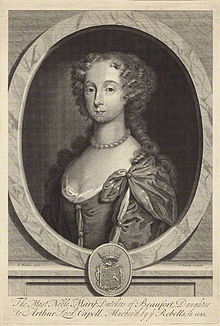Mary Somerset

Lady Mary Somerset, Duchess of Beaufort (baptized as Mary Capell on December 16, 1630 in Hadham Parva, Little Hadham , East Hertfordshire ; died January 7, 1715 in Chelsea , Middlesex ) was an English noblewoman and botanist .
family
Mary Capell was the daughter of Arthur Capell, 1st Baron Capell of Hadham , her brother was Arthur Capell, 1st Earl of Essex . She married Henry Seymour, Lord Beauchamp (c. 1626-1654), who was imprisoned as a royalist during the Commonwealth of England and died in the Tower of London in 1654 , they had a son and a daughter.
On August 17, 1657 she married Henry Somerset, 1st Duke of Beaufort (1629-1700), the second marriage , and they had three sons and four daughters.
Mary Somerset was buried in St Michael and All Angels Church at the family home in Badminton .
botany
At the age of 52 she bought "Beaufort House" in Chelsea in the neighborhood of the doctor Hans Sloane and devoted herself to the design of the garden there and at the Badminton House . In Badminton Gardens, which stretched over 52,000 acres , she had a 100- foot- long greenhouse ("Tropical stove") built, based on a construction that John Evelyn had introduced in England eight years earlier. The establishment and maintenance of the gardens required a large number of workers, which she directed with a strict hand; the female workers received half the pay of the men. Nevertheless, she appointed a woman to manage the greenhouse, which from then on formed the center of her botanical experiments.
At times she let the landscape architect George London and the botanist Leonard Plukenet work for her. In 1702 she employed William Sherard as a tutor for a grandson, and Sherard increased her collection and plant life in her gardens and introduced them to taxonomy . Her herbarium , which was laid out in the 1690s, was now organized according to scientific principles and comprised twelve volumes when she died. She bequeathed the herbarium to Sloane, and it went from him to the Natural History Museum in London, which today shows it as an example from the early days of scientific botany. In addition, she had Everhard Kick create the sheets for the “Badminton florilegium”, a two-volume collection of watercolors and drawings of plants by Kicks and other artists. The first volume was written between 1703 and 1705.
The genus Beaufortia , described in Australia in 1812 , was named after her.
literature
- Mark Laird: A natural history of English gardening, 1650-1800 . New Haven; London: Yale University Press, 2015
- Molly McClain: Beaufort: the duke and his duchess, 1657-1715 . New Haven: Yale University Press, 2001
- Horatia Durant: Henry, 1st Duke of Beaufort and his Duchess, Mary . Pontypool: Hughes & Son, 1973
- Douglas Chambers: "Stories of plants": the assembling of Mary Capel Somerset's botanical collection at Badminton , in: Journal of the history of collections, Vol. 9, no. 1 (1997) p. 49-60
Web links
- Literature by and about Mary Somerset in the WorldCat bibliographic database
Individual evidence
- ↑ Peter Lely: picture of the daughter Lady Elizabeth Seymour (c. 1655 - 1697)
- ^ A b c d Maud Goodhart: The constant gardener . In: Financial Times , May 23, 2015, p. 14 link
- ↑ Beaufortia , at FloraBase. Western Australian Herbarium.
| personal data | |
|---|---|
| SURNAME | Somerset, Mary |
| ALTERNATIVE NAMES | Mary Somerset, Duchess of Beaufort; Mary Seymour, Lady Beauchamp |
| BRIEF DESCRIPTION | English botanist and nobleman |
| DATE OF BIRTH | baptized December 16, 1630 |
| PLACE OF BIRTH | Hadham Parva, Little Hadham , East Hertfordshire |
| DATE OF DEATH | January 7, 1715 |
| Place of death | Chelsea (London) , Middlesex |

